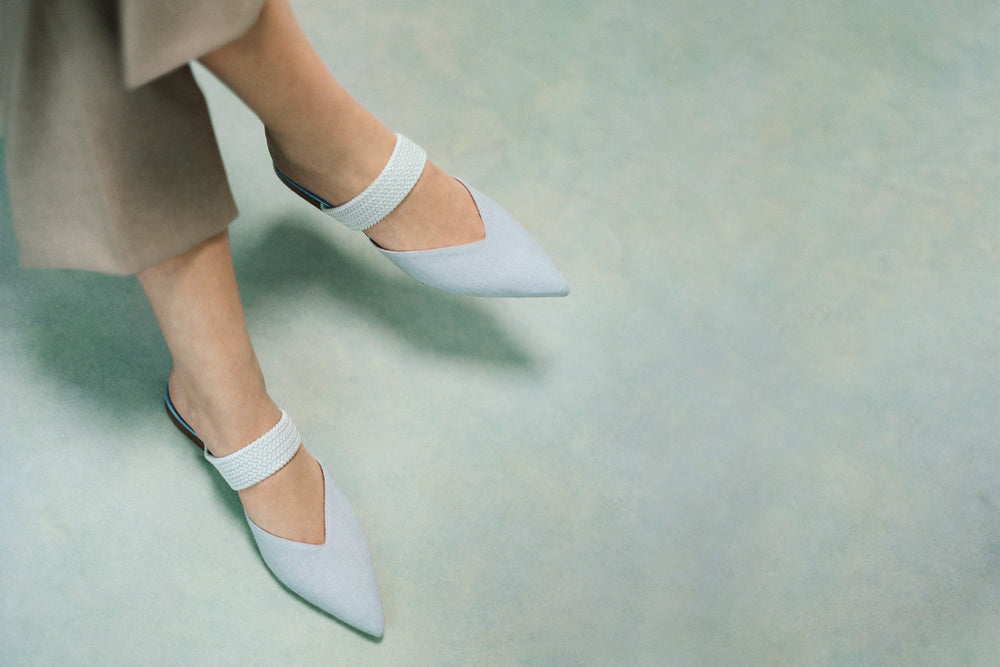By Katherine Ormerod
I remember the first time I saw Malone Souliers present at London Fashion Week. I was immediately struck by the craftsmanship—all shoes are Italian made—but also the vivid colours and immediately recognisable wave of the Maureen mule. This led me down an explorative path of better understanding the symbolic nature of the heel, its origins and its positioning in modern trends.
The Origin of High Heels
High heels were invented, believe it or not, for men. The origin of high heels is said to date all the way back to the 10th century and some of the original styles were worn by the 15th century Persian cavalry, who used the chink in the sole to ensure their feet locked in their horse’s stirrups. The trend spread and the status of owning your own horse—which had quite the social cachet—was soon denoted by the sporting of heels. While women got their own entry into the history of high heels with Venetian chopines—platforms of up to 30 inches high worn to avoid the less than savory streets, it was the princes and male aristocrats of the 17th century who really ran with the look. Or, more accurately sauntered: only someone who didn’t have to work could afford such impractical and extravagant shoes. And so, the modern high heel was born, but by the time of the French revolution, Enlightenment ideals had taken hold and heels were officially out for men and became instead, entwined with notions of femininity.

The chopines, originally designed to be worn by men
The Transformative Power of High Heels
As to the perennial question ‘Why do women wear high heels?’, the answers remain culturally as well as aesthetically diverse. The elongated silhouette; the ritz, glitz and glamour; the way they make your hips sway and tilt just so. Wherever you are on the history of high heels timeline, 1980s Stilettos, 1970s platforms or 1950s block heels, all have one thing in common: they change the way you feel when you wear them. From the swagger that heels—specifically comfortable heels—give you, to the way they can alter the proportions of your outfit, there is no denying that they have a transformative power.
Mary Alice Malone's Design Philosophy
Mary Alice Malone, Malone Souliers’ founder has always been captivated by the ways in which the high heel can totally change you, both psychologically and physically. Having trained at London Cordwainer’s College, Mary Alice has always prioritised comfort ahead of design detailing, and her definition of what makes a shoe sexy is intrinsically linked to a woman’s innate confidence. Unwearable shoes—however great they may look on the shelf—are never an option for walking tall and proud.

All Malone Souliers shoes are handcrafted in Italy by trained Cordwainers
You’d probably never believe why high heels were invented and the history of heels show the ways in which they have come to symbolise all sortS of social and gender-based standings. But today, it’s the styles like Malone Souliers’ signature Maureen mules which combine both the paradoxical empowerment and vulnerability inherent to any high heels which feel modern and relevant to contemporary women—though hat’s off to our Venetian sisters and their 30-inch wedges.

Katherine wears the Demi 70mm in Cognac Tan Mules
Since my first meeting with the Malone Souliers brand, I’ve become a fan of the Lucia mule, for its 85mm heel (to me the height which offers the very best balance) and the Demi block heel both of which are emblematic of Mary Alice’s design philosophy. Wearable, but ever-elegant, the Lucia for after dark and the Demi for day let you walk tall and proud, without ever compromising your comfort.



